Xianbin Wang
Trust Semantics Distillation for Collaborator Selection via Memory-Augmented Agentic AI
Sep 09, 2025Abstract:Accurate trustworthiness evaluation of potential collaborating devices is essential for the effective execution of complex computing tasks. This evaluation process involves collecting diverse trust-related data from potential collaborators, including historical performance and available resources, for collaborator selection. However, when each task owner independently assesses all collaborators' trustworthiness, frequent data exchange, complex reasoning, and dynamic situation changes can result in significant overhead and deteriorated trust evaluation. To overcome these challenges, we propose a task-specific trust semantics distillation (2TSD) model based on a large AI model (LAM)-driven teacher-student agent architecture. The teacher agent is deployed on a server with powerful computational capabilities and an augmented memory module dedicated to multidimensional trust-related data collection, task-specific trust semantics extraction, and task-collaborator matching analysis. Upon receiving task-specific requests from device-side student agents, the teacher agent transfers the trust semantics of potential collaborators to the student agents, enabling rapid and accurate collaborator selection. Experimental results demonstrate that the proposed 2TSD model can reduce collaborator evaluation time, decrease device resource consumption, and improve the accuracy of collaborator selection.
Agentic Graph Neural Networks for Wireless Communications and Networking Towards Edge General Intelligence: A Survey
Aug 12, 2025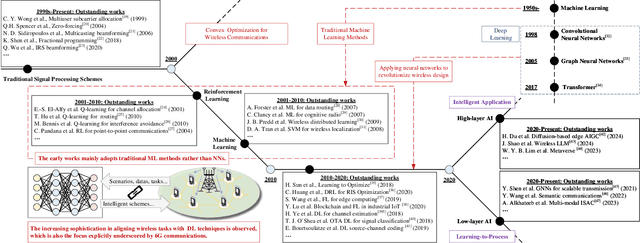
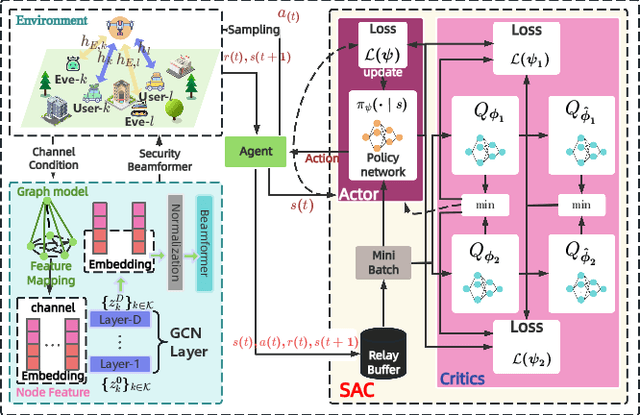
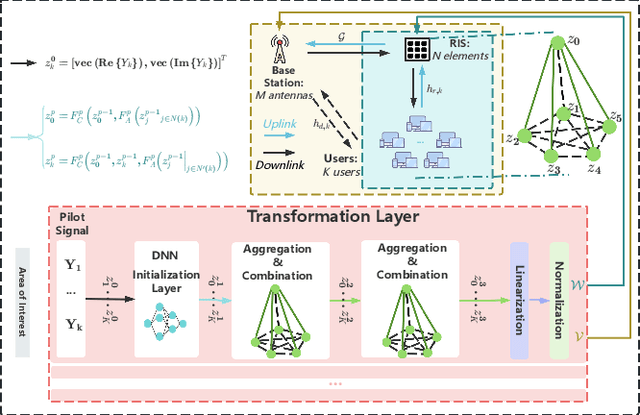
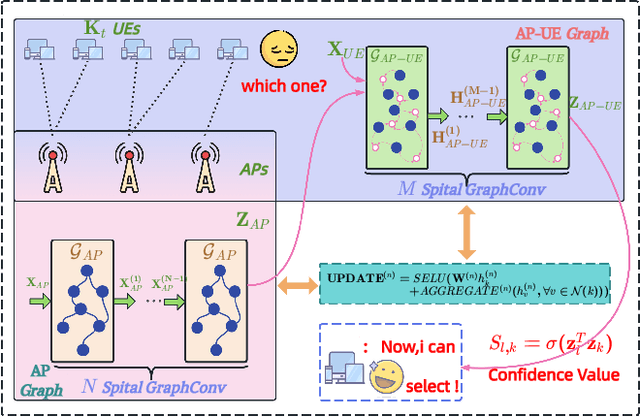
Abstract:The rapid advancement of communication technologies has driven the evolution of communication networks towards both high-dimensional resource utilization and multifunctional integration. This evolving complexity poses significant challenges in designing communication networks to satisfy the growing quality-of-service and time sensitivity of mobile applications in dynamic environments. Graph neural networks (GNNs) have emerged as fundamental deep learning (DL) models for complex communication networks. GNNs not only augment the extraction of features over network topologies but also enhance scalability and facilitate distributed computation. However, most existing GNNs follow a traditional passive learning framework, which may fail to meet the needs of increasingly diverse wireless systems. This survey proposes the employment of agentic artificial intelligence (AI) to organize and integrate GNNs, enabling scenario- and task-aware implementation towards edge general intelligence. To comprehend the full capability of GNNs, we holistically review recent applications of GNNs in wireless communications and networking. Specifically, we focus on the alignment between graph representations and network topologies, and between neural architectures and wireless tasks. We first provide an overview of GNNs based on prominent neural architectures, followed by the concept of agentic GNNs. Then, we summarize and compare GNN applications for conventional systems and emerging technologies, including physical, MAC, and network layer designs, integrated sensing and communication (ISAC), reconfigurable intelligent surface (RIS) and cell-free network architecture. We further propose a large language model (LLM) framework as an intelligent question-answering agent, leveraging this survey as a local knowledge base to enable GNN-related responses tailored to wireless communication research.
Advancing the Control of Low-Altitude Wireless Networks: Architecture, Design Principles, and Future Directions
Aug 11, 2025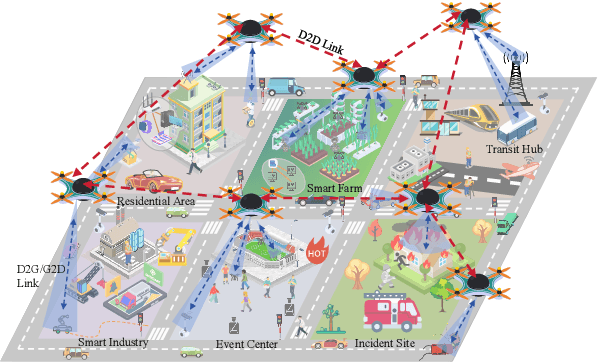

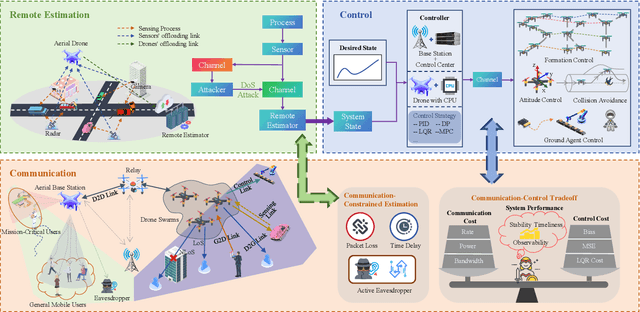
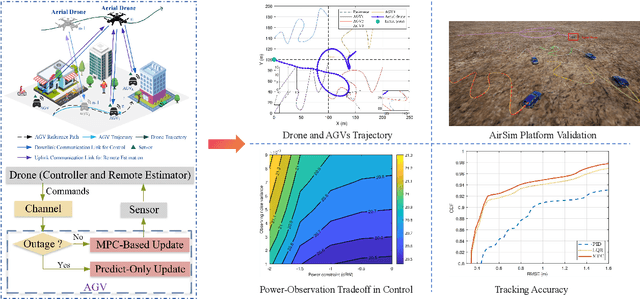
Abstract:This article introduces a control-oriented low-altitude wireless network (LAWN) that integrates near-ground communications and remote estimation of the internal system state. This integration supports reliable networked control in dynamic aerial-ground environments. First, we introduce the network's modular architecture and key performance metrics. Then, we discuss core design trade-offs across the control, communication, and estimation layers. A case study illustrates closed-loop coordination under wireless constraints. Finally, we outline future directions for scalable, resilient LAWN deployments in real-time and resource-constrained scenarios.
Energy-Efficient Design for Downlink Pinching-Antenna Systems with QoS Guarantee
May 20, 2025



Abstract:Pinching antennas have recently garnered significant attention due to their ability to dynamically reconfigure wireless propagation environments. Despite notable advancements in this area, the exploration of energy efficiency (EE) maximization in pinching-antenna systems remains relatively underdeveloped. In this paper, we address the EE maximization problem in a downlink time-division multiple access (TDMA)-based multi-user system employing one waveguide and multiple pinching antennas, where each user is subject to a minimum rate constraint to ensure quality-of-service. The formulated optimization problem jointly considers transmit power and time allocations as well as the positioning of pinching antennas, resulting in a non-convex problem. To tackle this challenge, we first obtain the optimal positions of the pinching antennas. Based on this, we establish a feasibility condition for the system. Subsequently, the joint power and time allocation problem is decomposed into two subproblems, which are solved iteratively until convergence. Specifically, the power allocation subproblem is addressed through an iterative approach, where a semi-analytical solution is obtained in each iteration. Likewise, a semi-analytical solution is derived for the time allocation subproblem. Numerical simulations demonstrate that the proposed pinching-antenna-based strategy significantly outperforms both conventional fixed-antenna systems and other benchmark pinching-antenna schemes in terms of EE.
Multi-Modal Multi-Task (M3T) Federated Foundation Models for Embodied AI: Potentials and Challenges for Edge Integration
May 16, 2025Abstract:As embodied AI systems become increasingly multi-modal, personalized, and interactive, they must learn effectively from diverse sensory inputs, adapt continually to user preferences, and operate safely under resource and privacy constraints. These challenges expose a pressing need for machine learning models capable of swift, context-aware adaptation while balancing model generalization and personalization. Here, two methods emerge as suitable candidates, each offering parts of these capabilities: Foundation Models (FMs) provide a pathway toward generalization across tasks and modalities, whereas Federated Learning (FL) offers the infrastructure for distributed, privacy-preserving model updates and user-level model personalization. However, when used in isolation, each of these approaches falls short of meeting the complex and diverse capability requirements of real-world embodied environments. In this vision paper, we introduce Federated Foundation Models (FFMs) for embodied AI, a new paradigm that unifies the strengths of multi-modal multi-task (M3T) FMs with the privacy-preserving distributed nature of FL, enabling intelligent systems at the wireless edge. We collect critical deployment dimensions of FFMs in embodied AI ecosystems under a unified framework, which we name "EMBODY": Embodiment heterogeneity, Modality richness and imbalance, Bandwidth and compute constraints, On-device continual learning, Distributed control and autonomy, and Yielding safety, privacy, and personalization. For each, we identify concrete challenges and envision actionable research directions. We also present an evaluation framework for deploying FFMs in embodied AI systems, along with the associated trade-offs.
Beyond ISAC: Toward Integrated Heterogeneous Service Provisioning via Elastic Multi-Dimensional Multiple Access
Apr 16, 2025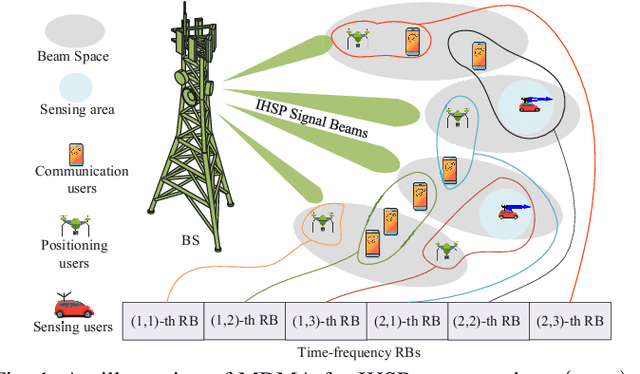



Abstract:Integrated heterogeneous service provisioning (IHSP) is a promising paradigm that is designed to concurrently support a variety of heterogeneous services, extending beyond sensing and communication to meet the diverse needs of emerging applications. However, a primary challenge of IHSP is addressing the conflicts between multiple competing service demands under constrained resources. In this paper, we overcome this challenge by the joint use of two novel elastic design strategies: compromised service value assessment and flexible multi-dimensional resource multiplexing. Consequently, we propose a value-prioritized elastic multi-dimensional multiple access (MDMA) mechanism for IHSP systems. First, we modify the Value-of-Service (VoS) metric by incorporating elastic parameters to characterize user-specific tolerance and compromise in response to various performance degradations under constrained resources. This VoS metric serves as the foundation for prioritizing services and enabling effective fairness service scheduling among concurrent competing demands. Next, we adapt the MDMA to elastically multiplex services using appropriate multiple access schemes across different resource domains. This protocol leverages user-specific interference tolerances and cancellation capabilities across different domains to reduce resource-demanding conflicts and co-channel interference within the same domain. Then, we maximize the system's VoS by jointly optimizing MDMA design and power allocation. Since this problem is non-convex, we propose a monotonic optimization-assisted dynamic programming (MODP) algorithm to obtain its optimal solution. Additionally, we develop the VoS-prioritized successive convex approximation (SCA) algorithm to efficiently find its suboptimal solution. Finally, simulations are presented to validate the effectiveness of the proposed designs.
Radiation Footprint Control in Cell-Free Cooperative ISAC: Optimal Joint BS Activation and Beamforming Coordination
Apr 15, 2025Abstract:Coordinated beamforming across distributed base stations (BSs) in cell-free architectures can efficiently support integrated sensing and communication (ISAC) users by improving resource sharing and reducing conflicts in the spatial domain. However, coordinating numerous BSs within the ISAC network poses risks of generating substantial interference for other networks sharing the spectrum, while also increasing operational costs from power consumption and signaling overhead. Therefore, in this paper, we propose an interference-suppressed and cost-optimized cell-free ISAC network by opportunistically and cooperatively orchestrating distributed radio resources to address competing sensing and communication (S\&C) demands. Specifically, we conceive a radiation footprint control mechanism that autonomously suppresses interference across the entire signal propagation space to safeguard other networks without exchanging signaling. Then, we propose joint BS activation and beamforming coordination to dynamically activate appropriate BSs and orchestrate their spatial beams for service provisioning. Building upon this framework, we formulate a cost-efficient utility maximization problem that considers individual S\&C demands and location-dependent radiation footprint constraints. Since this results in a non-convex optimization problem, we develop a monotonic optimization embedded branch-and-bound (MO-BRB) algorithm to find the optimal solution. Additionally, we apply a low-complexity iterative method to obtain near-optimal solutions. Finally, simulation results validate the effectiveness of the proposed algorithms.
Recent Advances in Near-Field Beam Training and Channel Estimation for XL-MIMO Systems
Apr 08, 2025Abstract:Extremely large-scale multiple-input multiple-output (XL-MIMO) is a key technology for next-generation wireless communication systems. By deploying significantly more antennas than conventional massive MIMO systems, XL-MIMO promises substantial improvements in spectral efficiency. However, due to the drastically increased array size, the conventional planar wave channel model is no longer accurate, necessitating a transition to a near-field spherical wave model. This shift challenges traditional beam training and channel estimation methods, which were designed for planar wave propagation. In this article, we present a comprehensive review of state-of-the-art beam training and channel estimation techniques for XL-MIMO systems. We analyze the fundamental principles, key methodologies, and recent advancements in this area, highlighting their respective strengths and limitations in addressing the challenges posed by the near-field propagation environment. Furthermore, we explore open research challenges that remain unresolved to provide valuable insights for researchers and engineers working toward the development of next-generation XL-MIMO communication systems.
Adaptive UAV-Assisted Hierarchical Federated Learning: Optimizing Energy, Latency, and Resilience for Dynamic Smart IoT Networks
Mar 08, 2025



Abstract:Hierarchical Federated Learning (HFL) introduces intermediate aggregation layers, addressing the limitations of conventional Federated Learning (FL) in geographically dispersed environments with limited communication infrastructure. An application of HFL is in smart IoT systems, such as remote monitoring, disaster response, and battlefield operations, where cellular connectivity is often unreliable or unavailable. In these scenarios, UAVs serve as mobile aggregators, providing connectivity to the terrestrial IoT devices. This paper studies an HFL architecture for energy-constrained UAVs in smart IoT systems, pioneering a solution to minimize global training cost increased caused by UAV disconnection. In light of this, we formulate a joint optimization problem involving learning configuration, bandwidth allocation, and device-to-UAV association, and perform global aggregation in time before UAV drops disconnect and redeployment of UAVs. The problem explicitly accounts for the dynamic nature of IoT devices and their interruptible communications and is unveiled to be NP-hard. To address this, we decompose it into three subproblems. First, we optimize the learning configuration and bandwidth allocation using an augmented Lagrangian function to reduce training costs. Second, we propose a device fitness score, integrating data heterogeneity (via Kullback-Leibler divergence), device-to-UAV distances, and IoT device resources, and develop a twin-delayed deep deterministic policy gradient (TD3)-based algorithm for dynamic device-to-UAV assignment. Third, We introduce a low-complexity two-stage greedy strategy for finding the location of UAVs redeployment and selecting the appropriate global aggregator UAV. Experiments on real-world datasets demonstrate significant cost reductions and robust performance under communication interruptions.
Privacy-Aware Joint DNN Model Deployment and Partition Optimization for Delay-Efficient Collaborative Edge Inference
Feb 22, 2025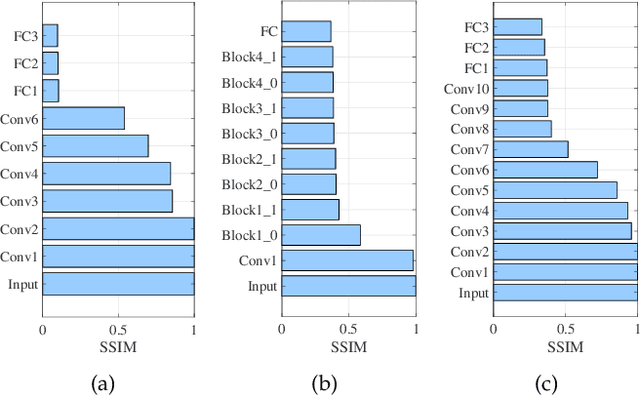


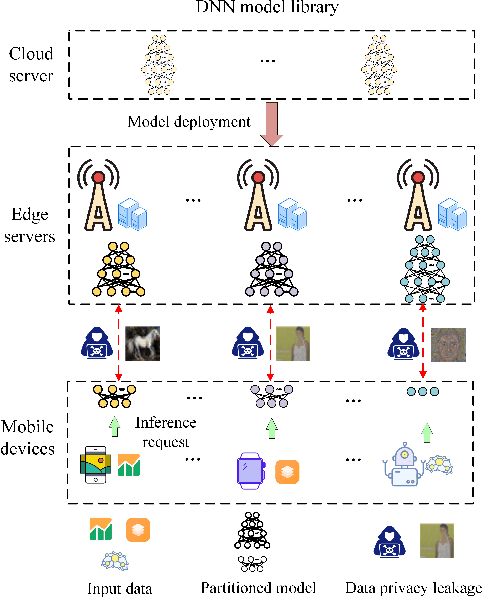
Abstract:Edge inference (EI) is a key solution to address the growing challenges of delayed response times, limited scalability, and privacy concerns in cloud-based Deep Neural Network (DNN) inference. However, deploying DNN models on resource-constrained edge devices faces more severe challenges, such as model storage limitations, dynamic service requests, and privacy risks. This paper proposes a novel framework for privacy-aware joint DNN model deployment and partition optimization to minimize long-term average inference delay under resource and privacy constraints. Specifically, the problem is formulated as a complex optimization problem considering model deployment, user-server association, and model partition strategies. To handle the NP-hardness and future uncertainties, a Lyapunov-based approach is introduced to transform the long-term optimization into a single-time-slot problem, ensuring system performance. Additionally, a coalition formation game model is proposed for edge server association, and a greedy-based algorithm is developed for model deployment within each coalition to efficiently solve the problem. Extensive simulations show that the proposed algorithms effectively reduce inference delay while satisfying privacy constraints, outperforming baseline approaches in various scenarios.
 Add to Chrome
Add to Chrome Add to Firefox
Add to Firefox Add to Edge
Add to Edge